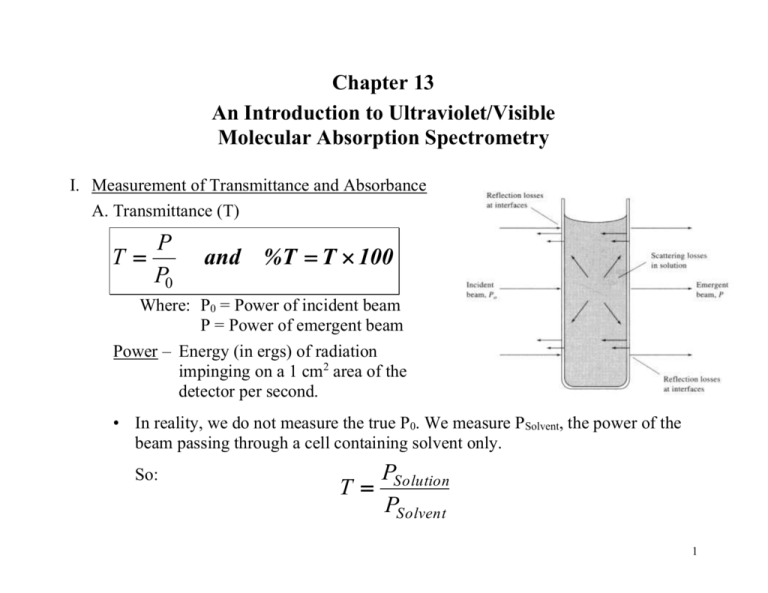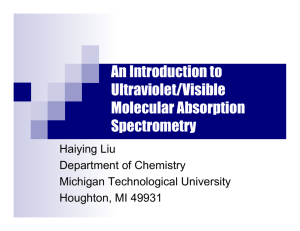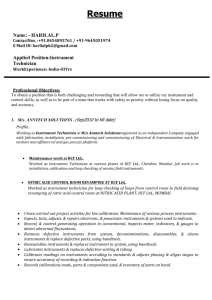Chapter13_notes
advertisement

Chapter 13 An Introduction to Ultraviolet/Visible Molecular Absorption Spectrometry I. Measurement of Transmittance and Absorbance A. Transmittance (T) P T P0 and %T T 100 Where: P0 = Power of incident beam P = Power of emergent beam Power – Energy (in ergs) of radiation impinging on a 1 cm2 area of the detector per second. • In reality, we do not measure the true P0. We measure PSolvent, the power of the beam passing through a cell containing solvent only. So: PSolution T PSolvent 1 B. Absorbance (A) PSolution PSolvent 1 A log T log log log PSolvent PSolution T C. Beer’s Law - the proportion of radiation absorbed is proportional to the thickness of the absorbing layer (b), the molecular concentration (c) of the absorbing species, and the molecular absorbing coefficient (a) of the species, which is characteristic of the species at a given wavelength. A abc When concentration (c) is expressed in molarity (mol/L) and thickness or pathlength (b) is expressed in centimeters, the molecular absorbing coefficient (a) is called molar extinction coefficient () and has units of liters per moles per centimeter [ L/(mol•cm) ]. A bc 2 • For mixtures Beer’s Law is additive. ATotal A1 A2 A3...... An ATotal or 1b1c1 2b2c2 3b3c3...... nbncn • According to Beer’s Law absorbance (A) is linear with respect to pathlength (b) and concentration (c), yet there are some real limitations to this relationship. • Limitations of Beer’s Law 1. A has no limitation with respect to b. • Use short pathlengths for samples of high concentration (absorbance). • Use long pathlengths for samples of low concentration (absorbance). Example: If A = 0.410 for a 1.0 cm cuvette (b = 1.0 cm) Then if: b = 2.0 cm, A = 0.820 b = 0.1 cm, A = 0.041 3 2. Chemical Deviations • A is linear with respect to concentration (c) except under conditions of high concentration or when chemical reactions are occurring. a. A usually becomes nonlinear with respect to concentration when c > 0.10 M • Above concentrations of 0.10 M the distance between analyte molecules decreases to the extent that they change each others charge distribution effectively changing the way they absorb radiation (i.e. changes). • The same effect is observed if the salt concentration in the solvent (or buffer) is too high. b. A becomes nonlinear when chemical reactions occur. • If the analyte associates, dissociates, or reacts with the solvent or other components in the solution, deviations from Beer’s Law will occur. Example: HIn H In Color 1 Color 2 4 3. Instrument Deviations a. Effect of polychromatic radiation • Ideally, a monochromator will pass radiation of a single wavelength, but in reality the monochromator passes a band of radiation. The bandwidth of the spectrometer will affect the linearity of Beer’s Law. • Measuring absorption off the wavelength of maximum absorption can affect the linearity of the Beer’s Law because of the change in wrt wavelength. • will vary across the bandwidth, so a plot of A vs. c can deviate from linearity. • Beer’s Law will be linear when the bandwidth is < 1/10 the width of the absorption peak at half height. 5 b. Scattered light that reaches the detector will increase PSolution. • Long pathlength cells cause more scattered light, which causes deviations from linearity in the relationship between A and b. * Note that all instrument deviations lead to negative absorbance errors. 6 II. Instrumentation A. Four basic types of instruments used for UV/Vis Spectroscopy • • • • Single-beam Double-beam in space Double-beam in time Multichannel 1. Single-beam instrument • These can be either single channel or scanning instruments. - 0% T is set with shutter in the beam path. - 100% T is set with a reference in the beam path - Measurement is then made with the sample in the beam path. 7 2. Double-beam in space instrument • Sample and reference are measured simultaneously and the signal from the reference is subtracted from the sample signal. • A major drawback of this type of instrument is the requirement of two detectors, which makes the instrument more expensive. 8 3. Double-beam in time instrument • Most common type of double-beam instrument commercially available. • Advantages of a double-beam over a single-beam instrument: a) Compensates for variations in the source intensity. b) Compensates for drift in the detector and amplifier (DB in time). c) Compensates for variation in intensity as a function of wavelength. 9 4. Multichannel instruments • Able to “scan” (collect) an entire spectrum in ~ 0.1 sec. • Uses signal averaging over a period of 1 sec or more to enhance signal-to noise ratio. • Have high throughput of radiant energy due to the minimal optics. • Typically use a deuterium lamp source for a spectral range of 200 nm 820 nm and have a spectral bandwidth (resolution) of 2 nm. 10 B. Components of UV/Vis Spectrometers 1. Source a. Tungsten lamp • Used for the visible region of the spectrum (350 – 800 nm). • Usually constructed of a quartz or glass bulb containing a tungsten filament. b. H2 or D2 lamp • Used for the ultraviolet region of the spectrum (160 – 350 nm). • The excited D2 will dissociate to give a continuous band of radiation. • Constructed of a quartz bulb filled with deuterium and a pair of electrodes. c. Xe lamp • Used when a high intensity lamp is required and emits a continuous band of radiation from 200 1000 nm. • Not very common because they are expensive and have a short lifetime. 11 2. Sample containers are usually cuvettes. • Constructed of either quartz or glass. - Glass is used for the visible region because it is transparent from 350 2000 nm. - Quartz (silica) is used for the UV region because it is transparent below 350 nm. • Cuvettes are commercially available in pathlengths of 0.1 10 cm. 3. Detectors • Use either a photomultiplier tube or a diode array. 12 C. Some typical instruments • Two major classifications of instruments: 1. Photometers - Simple instruments that use filters to select wavelength. They can only detect a single wavelength at a time, have a high throughput energy due to the simple optics (good S/N), and are inexpensive. 2. Spectrophotometers - Instruments that contain a monochromator or dispersive element that allow them to scan various wavelengths. More expensive than photometers and usually have a lower S/N due to the more complex optics. 13 1. Photometers a. Visible photometers 14 b. UV photometers • Common detector used for high performance liquid chromatography • Usually contain a Hg lamp as a source and the emission line at 254 nm is isolated by a filter. • Good for the detection of organic molecules, which absorb at 254 nm. c. Probe type photometers • Contain fiber optics and a mirror to project the source beam through the sample. • Commonly found in field instruments and eliminate the need for a sample cell. 15 2. Spectrophotometers a. Visible instruments • Inexpensive ($500 to $3000) • Range: 380 – 800 nm • Resolution: 8 –20 nm 16 b. Single- and double-beam UV/Vis spectrophotometers • Use exchangeable tungsten and D2 lamps • Range: 200 – 900 nm • Cost: $3000 - $8000 for SB, $4000 - $15,000 for DB • Resolution: 0.5 to 8 nm for SB, 0.1 to 3 nm for DB • Accuracy: 0.005 A for SB, 0.003 A for DB 17 c. Double-dispersing instrument • Light passes through the monochromator twice resulting in very high resolution. • Expensive: > $10,000 • Bandwidth: 0.07 nm • Stray light: 0.0008% 18 d. Diode array instruments • Can be very compact in size. • Fast scanning (~ 0.1 s) • Range: 200 820 nm • Bandwidth: 2 nm • Cost: $3000 $20,000 19










